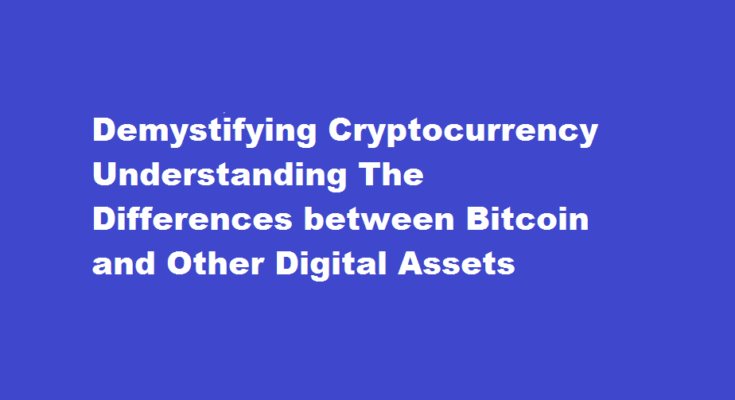Introduction
Cryptocurrency has revolutionized the way we perceive and interact with traditional forms of money. However, the term “cryptocurrency” is often used interchangeably with “Bitcoin,” leading to confusion among newcomers to the digital currency space. This article aims to shed light on the distinctions between cryptocurrency as a whole and Bitcoin as the most prominent and widely recognized example. By understanding these differences, readers will gain a clearer perspective on the diverse world of digital assets.
Cryptocurrency A Broad Definition
Cryptocurrency is a digital or virtual form of currency that uses cryptography for secure financial transactions, control the creation of additional units, and verify asset transfers. It operates on decentralized networks called blockchains, which rely on consensus mechanisms to maintain transparency and immutability. Bitcoin, introduced in 2009, was the first and remains the most well-known cryptocurrency. However, it is vital to recognize that Bitcoin is just one type among thousands of cryptocurrencies, each with unique features and purposes.
Bitcoin The Pioneer
Bitcoin, created by the pseudonymous figure known as Satoshi Nakamoto, emerged as the first decentralized cryptocurrency. It pioneered the use of blockchain technology, enabling peer-to-peer transactions without intermediaries like banks. Bitcoin operates on the principle of scarcity, with a limited supply capped at 21 million coins. It relies on proof-of-work (PoW) consensus, where miners solve complex mathematical puzzles to validate transactions and earn newly minted bitcoins as rewards. Bitcoin’s value is primarily driven by factors such as market demand, adoption, and speculative trading.
Altcoins Beyond Bitcoin
Altcoins, a term used to describe alternative cryptocurrencies, encompass all digital assets other than Bitcoin. They vary greatly in terms of underlying technology, purpose, and features. Some notable examples include Ethereum (ETH), Ripple (XRP), Litecoin (LTC), and Cardano (ADA). Unlike Bitcoin, which primarily aims to function as a digital currency, many altcoins serve as platforms for creating decentralized applications (DApps), smart contracts, or specialized utility tokens. Altcoins often employ different consensus mechanisms, such as proof-of-stake (PoS), which eliminates the energy-intensive mining process.
Utility Tokens and Security Tokens
Within the cryptocurrency landscape, tokens can be categorized as utility tokens or security tokens. Utility tokens represent access to a particular service or product offered by a blockchain-based platform. For instance, Binance Coin (BNB) grants discounted trading fees on the Binance exchange. Security tokens, on the other hand, derive their value from traditional financial instruments such as stocks or bonds. These tokens fall under regulatory frameworks and may require compliance with securities laws.
Frequently Asked Questions
What are the 4 types of cryptocurrency?
The four major types include utility, payment, security, and stablecoins. There also are DeFi tokens, NFTs, and asset-backed tokens. Of all cryptocurrencies, the most common are utility and payment tokens.
How do you explain Bitcoin and cryptocurrency to a newbie?
Cryptocurrency is digital money that doesn’t require a bank or financial institution to verify transactions and can be used for purchases or as an investment. Transactions are then verified and recorded on a blockchain, an unchangeable ledger that tracks and records assets and trades.
Conclusion
While Bitcoin holds its place as the most recognizable cryptocurrency, it is crucial to differentiate it from the broader concept of digital assets. Cryptocurrency encompasses a vast array of coins and tokens, each with unique features and purposes. Bitcoin, as the pioneering cryptocurrency, established the foundation for the industry, but alternative coins (altcoins) have since emerged, offering new possibilities beyond digital currency. Understanding these differences is essential for anyone venturing into the world of cryptocurrency, enabling informed decision-making and exploration of the diverse opportunities available.
Read Also : Unlocking The Potential A Guide to Opening a Dormant Account



